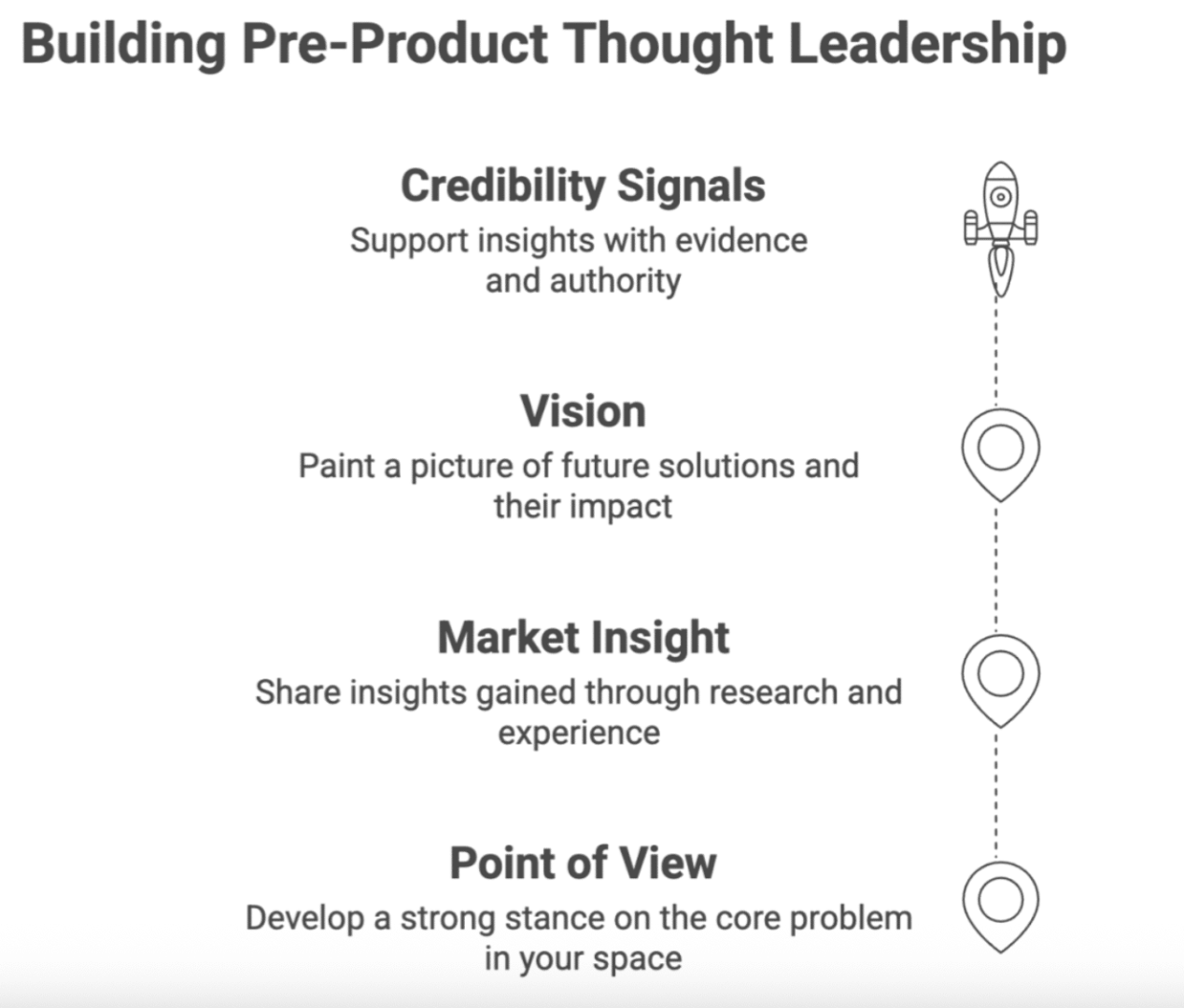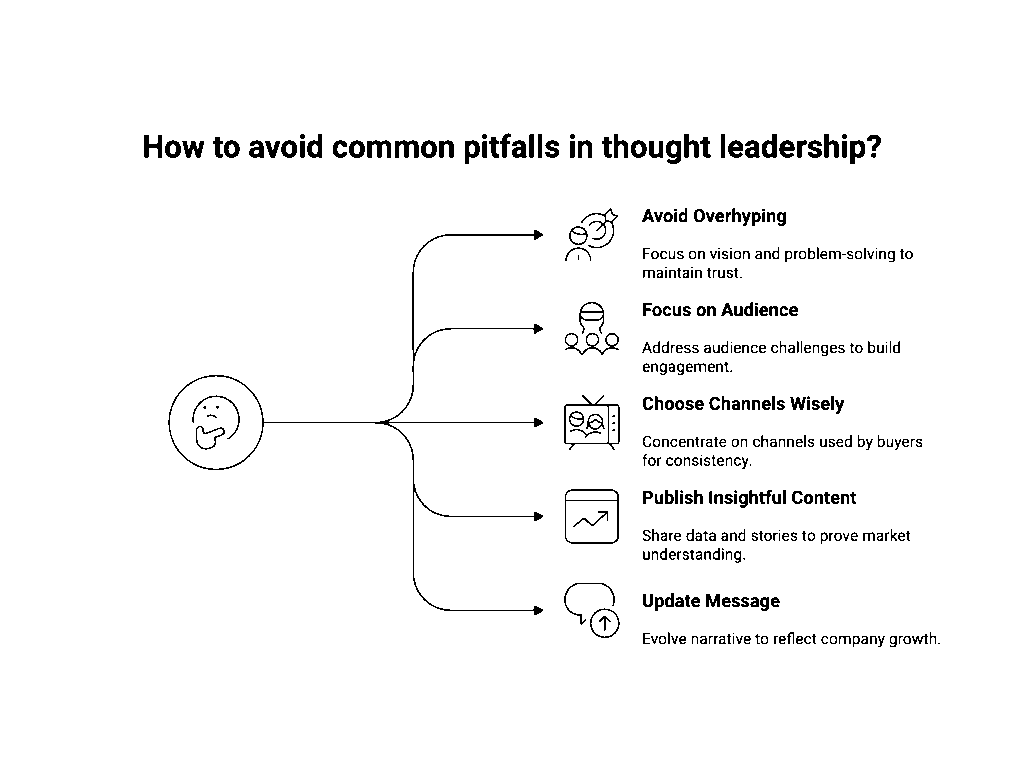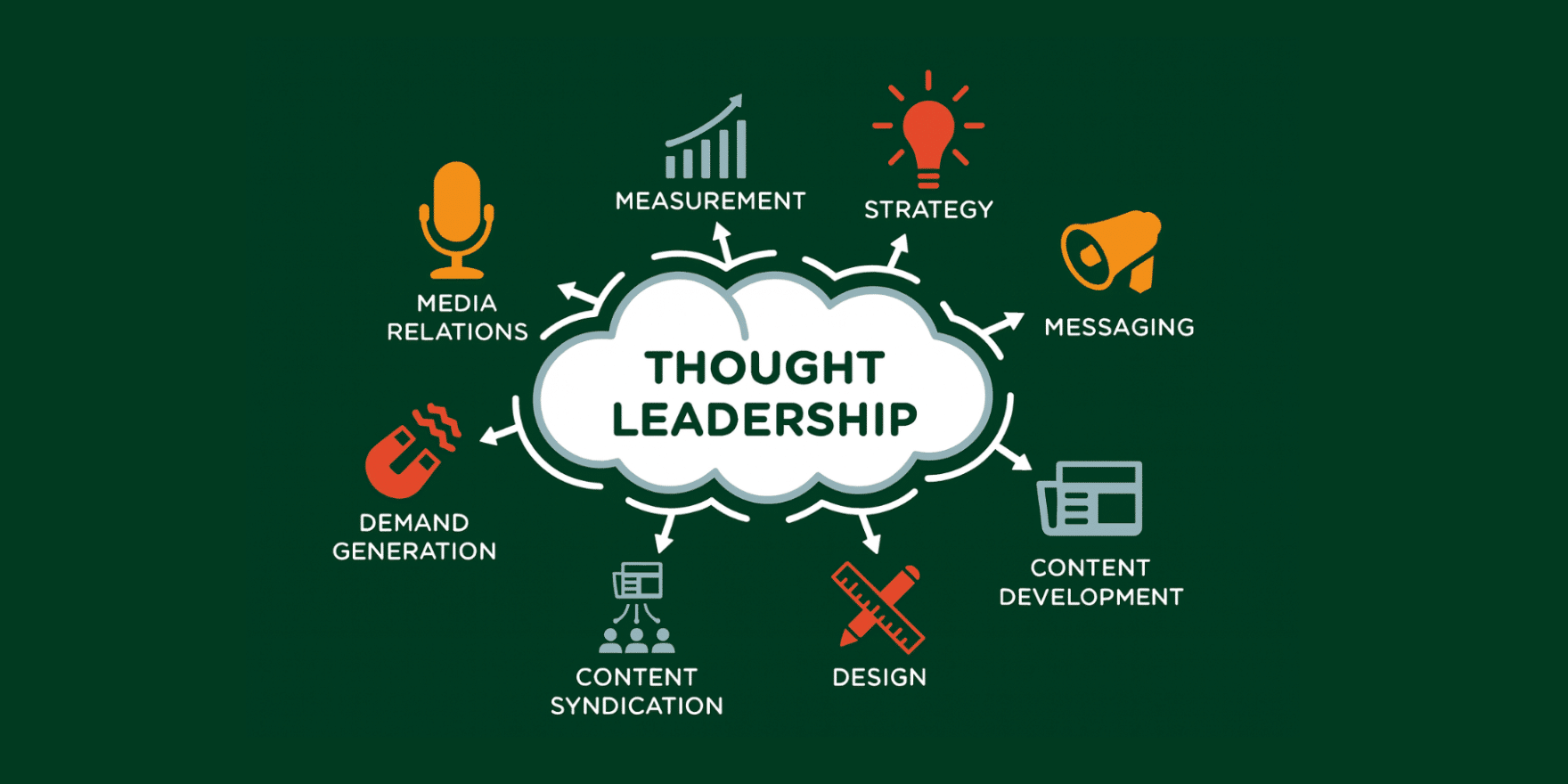Key Takeaways
- Be first, be trusted: Being early gives you the first-mover advantage.
- Ideas + outcomes win over features: Shape stories towards the problem statement and ideal outcomes.
- Leadership compounds: Starting early multiplies influence by the time you launch.
A classic founder problem is waiting until your product is in-market before you start building your authority. That choice creates a silent gap, giving competitors room to shape the narrative and build trust ahead of you. In fast-moving markets, the company that defines the conversation early earns the credibility others chase.
Your insights are your first product.
Thought leadership isn’t about features; it’s about proving you understand and love the problem you solve better than anyone else. Your insights are the first product the market sees. You need to be out there boldly, long before the Sign Up Now button is ready on your website. This is your opportunity to start earning attention pre-revenue that warms the path to a strong, early sales pipeline.
In this blog, we’ll show why establishing a strong thought leadership plan before your product launch is a market differentiator. You’ll also discover strategies founders win early with credibility building before their product is fully available.
What is Thought Leadership?
Thought leadership is the practice of positioning yourself or your company as the authority in a specific domain by consistently sharing unique insights, perspectives, and expertise. It is fundamentally different than product promotion because the goal is to show prospective customers how much you understand the problem and pain points they feel.
It’s about shaping the narrative, influencing industry conversations, and earning trust before you ever ask for a sale.
Why Thought Leadership Strategy Matters Before You Launch?
Thought leadership strategy establishes trust and credibility. In emerging or competitive industries, the company that defines the conversation early often becomes the default authority. By shaping how people think about the problem and the required capabilities for a solution, you set the stage for your product to enter with built-in legitimacy.
Research shows 73% of B2B buyers trust thought leadership more than marketing content. This means your ideas have an early influence.
Why Early Thought Leadership Outperforms Waiting
The difference between leading early and staying silent is significant. Here’s how the two approaches play out:
Early Thought Leadership | Waiting Until Launch |
Builds trust before revenue | Competes for attention late |
Shapes category conversation | Let others define the narrative |
Attracts investors and talent | Harder to stand out |
Choosing to lead early increases your influence. The sooner you share insights, the faster you build trust, credibility, and attention. For example, Salesforce’s early ‘The End of Software’ campaign, launched around its February 2000 debut, helped define the SaaS category before its CRM product matured. It proved that bold ideas and differentiated market framing can establish leadership before features are even .
Core Elements of a Strategic Thought Leadership Plan
Before you launch, your audience has no features to test. What they do have is your voice, perspective, and credibility. Four elements make pre-product thought leadership resonate effectively.
Point of View (POV)
A strong POV cuts through noise. Take a stance on the core problem in your space. Instead of saying “security is important,” say “attackers exploit people before they exploit code.” Bold positions give buyers something to remember and strive around.
Market Insight
Audiences trust founders who identify trends before others. Share insights gained through research, customer interviews, or industry experience. Translate technical or market complexities into simple, actionable takeaways. When you identify risks or opportunities that others miss, you prove leadership.
Vision
Your vision connects today’s challenges to tomorrow’s solutions. Illustrate where the market is heading and explain its significance. Make it concrete: describe how workflows will change, costs will decrease, or risks will be minimized. A clear vision encourages buyers, investors, and talent to join you on your journey.
Credibility Signals
Authority isn’t built on words alone. Support your insights with evidence. Cite data, share stories from early customer conversations, highlight respected advisors, or draw on your own track record. These signals reassure your audience that your claims are grounded in fact, not speculation.

When you combine POV, insight, vision, and credibility, you create thought leadership that feels real. That combination builds trust faster than features ever could.
3 Steps to Build Strategic Thought Leadership Before You Have a Product
You don’t need perfectly polished assets to lead. Your content is part of your MVP; you want to ship what you’re building to get more opportunities to test in-market. Post about tradeoffs, early decisions, or even failures. This “build in public” approach earns trust because people value honesty over perfection.
Teach the Problem, Not the Product
Write about the pain points your audience struggles with. Explain why they exist and what happens if they remain unsolved. This shows you understand the problem space better than competitors, even before you release a solution.
Create Small Platforms
Start a roundtable, podcast, or even a simple webinar. Invite industry experts, early adopters, or advisors. Publishing their insights gives you credibility by association while positioning you as the one who convenes valuable conversations.
Meet Buyers Where They Are
Don’t scatter across every platform. Pick one or two where your buyers already spend time, LinkedIn or niche Slack groups, and engage consistently. Short, pointed insights outperform long, irregular updates.
For example, a founder in cybersecurity began posting weekly breakdowns of real-world breaches on LinkedIn. Within months, those posts attracted thousands of practitioners and built a waitlist of potential customers before a product existed.
Turning Strategy into a Repeatable System
Many founders start strong, then lose momentum. Compared to running the company, thought leadership content creation is treated like a side project. You need to make it part of your routine, not an extra task that just gets deferred until it’s perpetually pushed out of mind.
Think of every conversation with investors, advisors, or early customers as raw material. A single call can turn into a LinkedIn post, a short video, or a blog post. Repurposing keeps your pipeline full without adding new workload.
Trust is damaged when your investor pitch emphasizes one vision, while your social media posts convey a different message. Align your story across decks, interviews, and content to ensure your audience receives the same message throughout.
Quick Checklist:
Here are three simple ways to keep your thought leadership efforts sustainable:
- Set a cadence you can keep (weekly is enough).
- Repurpose notes and transcripts into content.
- Keep your message consistent across all platforms.
By treating content like a system instead of an occasional task, you’ll keep your voice active in the market without draining your time or focus.
Common Pitfalls to Avoid While Building Thought Leadership
Founders have a lot to deal with while building the company. You face constant friction with time, messaging challenges, positioning, ICP development, and getting the company brand out to the world. Offloading writing or defocusing from “the problem” leads to either no thought leadership presence or content becomes too “feature-focused”.
Here are the top risks to watch for in your thought leadership content:
- Overhyping Product Specifications: Talking about features before they exist can erode trust. Focus on the problem and your vision, rather than making promises you can’t keep.
- Making It About You: Thought leadership fails when it turns into self-promotion. Shift the focus to your audience’s challenges and what they need to learn.
- Spreading Too Thin: Trying to be everywhere dilutes your message. Pick one or two channels your buyers actually use and show up consistently.
- Publishing Generic Content: Empty statements like “innovation is important” add no value. Share insights, data, or stories that prove you understand the market.
- Ignoring Growth: As your company matures, update your message. A static narrative signals you’re stuck in the past.

By avoiding these pitfalls, you keep your message sharp, your audience engaged, and your credibility intact, setting the stage for thought leadership that grows with your company.
How GTM Delta Can Help You
Building thought leadership takes time, consistency, and skill. Founders know they need to lead with their perspective, but staying visible while building a product is overwhelming. GTM Delta solves this by capturing and scaling your founder’s point of view without pulling you away from your core priorities. You focus on building; we ensure your insights reach the market in time and in your voice.
Our research processes and rapid delivery model give you the volume, cadence, and technical depth needed to target your ideal audience. Our content is designed to build credibility. Engineers, scientists, and technical experts craft material that resonates with sophisticated audiences, while seasoned marketers refine it for clarity, reach, and impact. The result is content that your buyers trust, because it reflects both technical depth and market relevance.
We also bring structure to what often feels chaotic. Using repeatable frameworks, we turn your calls, investor decks, and raw notes into market-ready narratives. This ensures you own your niche conversation before launch, establishing authority long before competitors even show up.
Bringing It All Together
Thought leadership should not wait until your product launch. By sharing your point of view early, you build trust, shape your niche, and attract attention that grows over time. Your insights are the first product the market sees, and they create the foundation for everything that follows.
Start now, focus on problems, patterns, and vision. Avoid the common pitfalls of overhyping, generic content, or spreading yourself too thin. Instead, use consistency and authenticity to keep your message sharp and your audience engaged.
With GTM Delta, you don’t have to choose between building your product and building your voice. We help you transform raw expertise into a market-shaping narrative at product speed. Your credibility grows, your category position strengthens, and your future customers already trust you before launch day arrives.
Begin leading your market today. Your ideas are ready even if your product isn’t.






